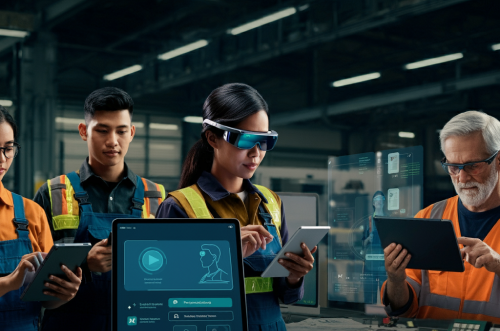Rapid and effective onboarding of new workers has become a ‘must-have’ capability for companies as they rebuild post-pandemic workforce skill sets. In today’s everything-digital age, digitalizing onboarding offers the flexibility and accessibility that traditional classroom and paper-based methods lack. However, like any tool, digital training can be ineffective if not implemented correctly. In addition, many companies find that online courseware, as enabled by most computerized Learning Management Systems (LMS), is not enough for the new workforce demographics. Here are some of the most common pitfalls for the digitalization of new worker onboarding:
1. Overloading Content
Digital training offers the convenience of delivering vast amounts of information more easily. To avoid overwhelming new workers with too much content at once, which can make it difficult for workers to retain essential information, break down training into manageable modules and use microlearning techniques to keep content digestible.

2. Ignoring Engagement
Digital courseware often lacks the interactive elements that make classroom training engaging. Relying solely on presentations or text-heavy modules can result in disengagement. Videos help but are not a panacea. To maintain interest, incorporate multiple elements into training and include interactive tools such as quizzes, simulations, and interactive content.

3. Lack of Personalization
One of the most significant mistakes is treating digital training as a one-size-fits-all solution. Each new hire has unique skills, experiences, and learning styles, particularly now that workforce demographics may span three generations. Failing to personalize the training experience can lead to disengagement and slower ramp-up. Consider offering tailored learning paths that allow workers to focus on areas where they need to upskill while bypassing content they already know.

4. Inadequate Assessment and Feedback
Another common mistake is not providing adequate assessment and feedback mechanisms. Proper evaluation makes it easier to gauge how well workers understand the material or identify areas where they need more support. Include regular assessments, such as quizzes or assignments, and provide timely feedback to help workers track their progress and address any learning gaps.

5. Failing to Integrate with Company Culture
While the transfer of knowledge is a primary goal of onboarding, failing to integrate cultural elements into the training can leave new hires feeling disconnected. Include modules on company values, mission, and expected behaviors to help employees understand and embrace the organizational culture.

Digitalize Onboarding With Best Practices In Mind
Despite potential challenges, digitalizing the onboarding process is undoubtedly a necessity for companies rebuilding their workforce, whether that is due to skills gaps from the attrition of experienced workers or the need to expand the workforce to drive growth. According to a McKinsey study, companies that invested in frontline training, and development saw double revenue growth rates and 37% less worker attrition than other companies that were also reviewed in the study. Digital training is also becoming table stakes as companies compete for workers who are accustomed to doing everything on a mobile device.
Learning In The Flow Of Work
Digital training courseware is a powerful tool for onboarding new workers, but its effectiveness depends on avoiding common pitfalls. Following best practices like incorporating microlearning, building engaging and interactive content, personalization and feedback, and digitalizing onboarding training can help companies successfully transform their onboarding programs. At ROO.AI, we believe that the digitalization of onboarding is just the first step.

Josh Bersin, a Deloitte Partner and head of their corporate learning practice, wrote an interesting article where he coined the phrase ‘Learning in the flow of work. He sees the future of training as fusing microlearning apps into the digital platforms that workers use to get their jobs done. He also points to studies showing that 49% of workers want to consume training at the point of need.
Reimagining training as a component of the work process not only represents a game-changer in workforce onboarding and development but also becomes a driver to bridge the growing skills gaps and boost worker productivity and quality…



